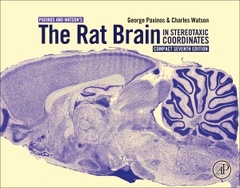Description
The Rat Brain in Stereotaxic Coordinates: Compact (7th Ed.)
Authors: Paxinos George, Watson Charles
Language: English
Subjects for The Rat Brain in Stereotaxic Coordinates: Compact:
122.46 €
In Print (Delivery period: 14 days).
Add to cart388 p. · 21.5x27.6 cm · Loose-leaf
Description
/li>Contents
/li>Readership
/li>Biography
/li>Comment
/li>
The Rat Brain in Stereotaxic Coordinates Compact, Seventh Edition is a smaller sized (8.5 x 11inch), abridged version of the most referenced work in neuroscience (over 35,000 citations). The compact edition provides the coronal plates and diagrams of the current seventh edition in a smaller, more convenient spiral format and at a student friendly price. This book includes an introduction on current concepts in neuroanatomy, such as neuromeres and brain development. Students and seasoned researchers will find the first major unified nomenclature ontology tree based on development that features coronal photographic plates and juxtaposed diagrams.
2. Introduction to the concept of neuromeres and brain development
3. Overview of the brain for students, including three sagittal, five coronal, and two horizontal simplified diagrams, as well as surface diagrams of the brain
4. Nomenclature ontology tree
5. 161 coronal diagrams and corresponding photographic plates
Charles Watson is a neuroscientist and public health physician. His qualifications included a medical degree (MBBS) and two research doctorates (MD and DSc). He is Professor Emeritus at Curtin University, and holds adjunct professorial research positions at the University of New South Wales, the University of Queensland, and the University of Western Australia.
He has published over 100 refereed journal articles and 40 book chapters, and has co-authored over 25 books on brain and spinal cord anatomy. The Paxinos Watson rat brain atlas has been cited over 80,000 times. His current research is focused on the comparative anatomy of the hippocampus and the claustrum.
He was awarded the degree of Doctor of Science by the University of Sydney in 2012 and received the Distinguished Achievement Award of the Austra
- Features 161 coronal diagrams and accompanying photographic plates spaced at constant 120 micron intervals
- Includes a simplified mini-atlas for beginning neuroscientists, and for teaching purposes
- Covers the most accurate and widely used stereotaxic coordinate system
- Presents diagrams that are identical to those in the full Seventh Edition
- Includes the Expert Consult eBook version, compatible with PC, Mac, and most mobile devices and eReaders, which allows readers to browse, search, and interact with content




